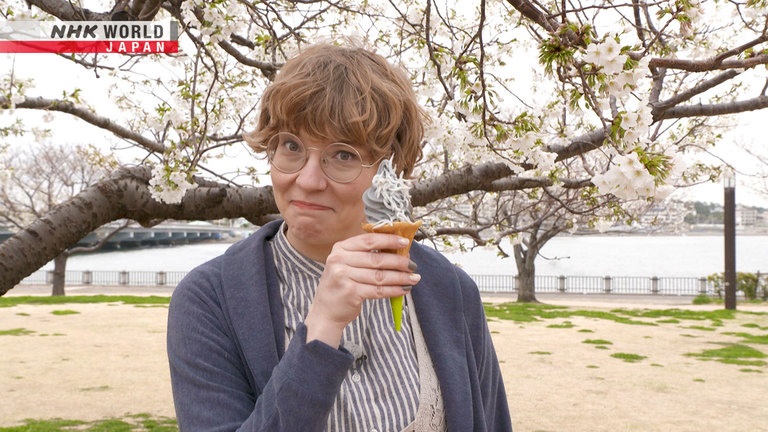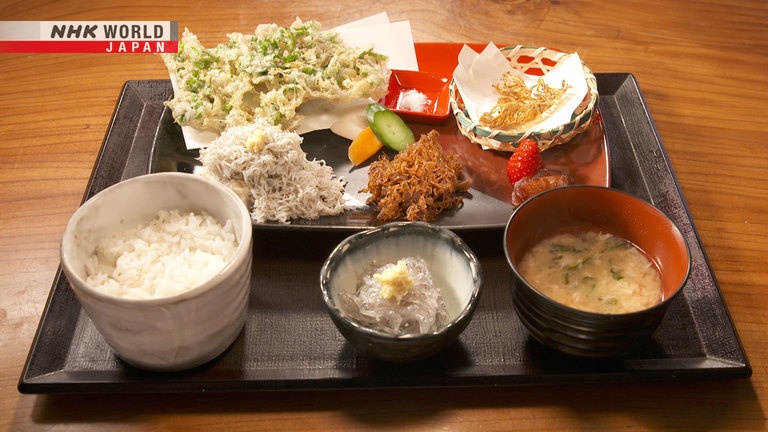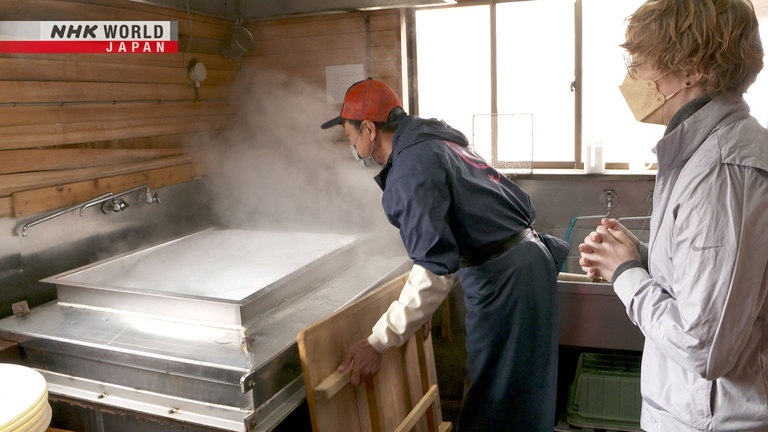SHIRASU
Silvery-white Shirasu, or baby Japanese anchovies, are caught along Japan's coasts in the spring and fall. Find boiled and dried ones at your local supermarket, or head closer to a fishing port to savor raw Shirasu. Hauls from a Kanagawa port get eaten up locally before they can reach markets in neighboring Tokyo! Join us on a fishing trip to see how Shirasu are processed, and check out a French restaurant that incorporates the ingredient. (Reporter: Kailene Falls)




Transcript
Tokyo: this world-class metropolis is a veritable gourmet wonderland.
Discover the stories behind the ingredients that make this city so delicious - so "oishii."
This time, we focus on shirasu, or whitebait.
What are they exactly?
Shirasu are baby Japanese blue-backed fish, like anchovies.
They're clear and silvery-white.
Shirasu are mainly caught along Japan's Pacific coast during two peak seasons, in spring and fall.
They're high in protein, low-calorie, rich in calcium, and loaded with vitamin D and B12.
Shirasu are usually boiled and dried.
But if you venture closer to a fishing port, you can savor them while they're still raw.
Great reaction.
It's that good.
I love shirasu, but have
never tried it this way.
"Oishii!"
They may not look like much, but they're a key part of Japanese cuisine.
Dive in to find out why Japan has a lot of love for such a tiny fish.
Trails to Oishii Tokyo.
Hi, it's Kailene.
Today we're going to learn about shirasu.
When I showed a photo of shirasu to my family in the US, they weren't convinced of its edibility, and, to be honest, the first time I saw it, I wasn't either.
However, shirasu works incredibly well in both Japanese and Western dishes, so I want to use this opportunity to learn about shirasu
as well as convince everybody watching that shirasu is a delicious ingredient not to be missed.
The first stop is the bustling Toyosu Market.
Kailene visits a seafood wholesaler offering a wide selection of shirasu.
Shirasu!
Hi! Nice to meet you.
I’m Kailene.
Hi. I’m Yamashita.
I sell shirasu.
So many kinds.
Right.
I love shirasu, but never
considered the differences.
They sell shirasu from all over Japan.
They’re very delicate.
Even in the same region, size and color vary
depending on weather and water conditions.
Right. I see different sizes here.
Are these all the same type?
They’re all baby fish,
mostly baby anchovies.
But what each type is called
depends on how they’re prepared.
Shirasu boiled in salt water are called kama-age (shirasu).
Boiled and partially-dried ones are called shirasuboshi, and ones that are boiled and dried more are called chirimenjako.
A lower water content means stronger umami.
How are each used in dishes?
Kama-age shirasu are good over rice,
for rice bowls.
Also a great choice for toast,
pizza and pasta.
I know the shirasu rice bowls
and pizza I’ve had used that type.
What about this one?
Steaming or stir-frying chirimenjako
with rice enhances their umami.
I see.
You know the dried fish ingredient called niboshi that's used to make dashi stock?
They're usually anchovies too.
I’ve never been particular about
which ones I buy at the supermarket.
Any tips for choosing good ones?
Get the ones with red
spots on their belly.
Oh, they do have red bellies.
Why is that?
It means they’re full of tasty
shrimp and crab plankton.
The color’s from the shrimp?
Right.
Wow!
The umami is maybe four times
stronger than regular shirasu.
Amazing.
Where are shirasu caught?
In the Pacific Ocean, from Kagoshima
in the west to Miyagi in the north.
That's quite a large area.
The nearest place to Tokyo
would be Kanagawa.
They’re caught there too.
But demand in Kanagawa is high, so
not many of those reach this market.
I’d really like to taste some.
Please do.
Shirasu caught in Kanagawa's Sagami Bay are called Shonan shirasu.
They symbolize the coming of spring.
Most of what's landed at ports around Sagami Bay is eaten locally.
Kailene heads to a popular spring and summer destination called Enoshima, a small island just off the mainland.
This area is really famous for its shirasu, and they even have shirasu ice cream.
I'm not so sure about this, but let's give it a try.
It's surprisingly delicious.
The fish flavor isn't strong at all, so it's almost like, just like a little bit of saltiness alongside your ice cream.
Very good.
Now to a shirasu restaurant back on the bay.
It's actually run by a fisher.
Here is the first dish.
Beautiful.
I love shirasu rice bowls.
Raw shirasu on one side
and kama-age shirasu on the other.
We only serve raw shirasu
on the same day they’re caught.
So you can’t offer it every day.
That’s right.
Lucky me!
Over the raw shirasu, pour some soy sauce to taste.
Let's eat.
I'll try the raw ones first.
It was smooth and easy to eat.
A bit sweet too!
Now for the slightly salty kama-age shirasu.
It’s nice to enjoy two different textures.
The raw ones are plump.
The boiled ones are softer.
It’s fun to chew them together.
Fantastic.
Sashimi and sushi fans
would enjoy the raw shirasu.
People who don’t prefer raw
fish can enjoy the boiled ones.
Next up is a meal that reminds you where you are-the land of shirasu!
Here you are.
Wow. Look at that.
This is our most popular dish.
Many different ways
to enjoy shirasu here.
I’m drooling.
It looks so good.
These are quite brown,
but they look like shirasu.
We dry kama-age shirasu in the sun
to make them crispy.
Then they’re returned
to a pot to make tsukudani.
So, we stew them.
Interesting.
That makes them a bit tender.
It's flavored with sugar and soy sauce.
Here we go.
Another great texture.
Nice and firm.
It’s sweet with some bitterness.
A pretty complex, delicious flavor.
Perfect with rice.
That’s how everyone eats it here.
I love the variety in this dish.
Now, I’m really curious about this one.
It’s called tatami iwashi.
In the Shonan area, shirasu processing dates back to the mid-18th century.
Shirasu are put in wooden molds to create sheets that are laid out to dry in the sun.
They're placed on igusa mats, which are used to make tatami floors-hence the name tatami iwashi.
Their long shelf life made them a local favorite.
Chirimenjako also keep well.
Chirimenjako mixed with sansho pepper and kombu kelp goes great with rice, and it's also a popular gift.
This restaurant serves tatami iwashi made the traditional way deep fried.
Okay, so this is my first time ever eating anything remotely similar to this.
I like shirasu in other ways, though, so I have high hopes for it.
Let's go.
It has a strong but pleasant aroma.
It reminds me of senbei crackers.
I thought their small size would
make them difficult to cook with.
But we have different cooking methods
giving different flavors and textures.
You’ve shown me the possibilities.
Shirasu are eaten in other parts of the world too, like in Italy and New Zealand, but they're mostly cooked.
A focus on enjoying shirasu raw or preserving them for later is something truly unique to Japan.
Hiratsuka Fishing Port is about a dozen kilometers down the coast, west of Enoshima.
Good morning.
Thanks for having me today.
Welcome!
The crew had on their trademark pink uniforms!
Sugiyama Takeshi comes from a long line of fishers, going back to the Edo period.
He's been fishing shirasu for 40 years.
To protect resources, fishing is prohibited by the local government from January to mid-March.
Shirasu form schools as the sun rises, so the crew sets out early.
Some small waves.
Yeah, it’s a bit rough today.
Does that affect the catch?
It’s not ideal.
Shirasu are tiny, so waves
frighten and scatter the schools.
About 10 minutes from land, they begin to see movement.
These are shirasu.
Yeah?
None on the left, right?
The things on both sides aren’t shirasu.
They’re here, but not so many.
Not many?
Well, I wouldn’t know.
This was late March, right after regulations were lifted.
Mr. Sugiyama said the schools wouldn't be so big yet.
Time to fish!
These first nets are used to scare the shirasu into forming a group.
This net here is the real trap.
Two nets with large holes are connected to one with smaller holes.
Once the fish are surrounded, the boat is driven forward at a low speed.
Avoiding the first nets, the shirasu gradually end up in the main trap.
About 15 minutes have passed since the nets were set.
Time to haul them in.
Inside, they find shirasu.
That’s quite a bit.
Not at all.
Really?
You made it sound like we
wouldn’t catch any at all today.
As fresh as it gets!
Kailene's in for a real treat.
So fresh! "Oishii!"
Great.
I love raw shirasu, and now
I’m eating it on a fishing boat!
The flavor is mild.
Right.
Spring ones are smaller and finer.
The shirasu are quickly rinsed in seawater to remove dirt and grime before they spoil.
Ice is added to keep them fresh.
This prevents decomposition, and keeps inosinic acid, an umami compound, from breaking down.
Nets were put out three times over two and a half hours before we headed back to port.
Looks like a lot to me.
No, this is a small haul.
Yeah?
A bit disappointing.
How much on a good day?
In this amount of time, we could
fill three or four of these.
Once landed, they're rushed to a dedicated workshop.
Here, the fish are boiled to make kama-age shirasu.
That's big.
It is.
They won't turn out well unless
there's space to move as they boil.
Adding naturally dried salt that's rich in minerals to the boiling water softens the flavor of the fish.
The shirasu go in after they're rinsed with fresh water.
The color changed instantly.
Completely white.
They boil for five minutes.
Here we go.
Lovely smell!
Definitely.
Done! All set!
When boiled, the best ones
form a hiragana "shi" shape.
Fresher means a more pronounced bend.
Easy to remember.
It does look like the "shi" character.
Kama-age shirasu, fresh out of the pot.
Kailene gets the first taste.
Enjoy!
Looks great!
"Oishii!"
Such a nice flavor.
I’m so happy to eat
freshly-boiled shirasu.
Thank you.
That’s the advantage of fishers here
catching and preparing it themselves.
We’re happy if more people can enjoy it.
It was amazing to see how the fishers do everything themselves, from fishing to boiling, to provide the best shirasu they can.
Shonan is a shirasu paradise.
It's a wonderful getaway not far from Tokyo!
Kailene's final stop is Kagurazaka, a gourmet district in Tokyo with many hidden gems.
She heads to a casual French restaurant that does both a la carte and course meals.
This is Nakada Takahiro.
After training at top French restaurants both in and outside Japan, he opened the restaurant in hopes of incorporating local ingredients into what he learned.
He uses a "chirimenjako" and "sansho pepper" mix that's seasoned with soy sauce.
Can you guess what he's making?
A Japanese omelet!
It's been a hit since he opened.
This smells so good!
Chirimen sansho omelet.
The egg has dashi from
simmered chirimenjako.
It’s a rolled dashi omelet.
Let’s eat!
Delicious!
And sweet.
Japanese omelets are so fluffy.
The firm chirimenjako
add a fun texture to that.
Right. A fluffy egg texture
combined with a firmer texture.
It’s sweet, rich, and even a bit sticky?
The next dish features a sauce unique to French cuisine.
With meat?
Meat and fish.
Not your everyday combo.
This sauce is served over
rainbow trout fillets in Grenoble, France.
And I used shirasu instead of croutons.
The fish umami and rich butter
compliment the light, smooth veal.
Veal gravy is drizzled around.
Let me taste.
Bon appétit.
Also very delicious! Wow!
It may seem like a strange match,
but the umami mix is really great.
A complex flavor.
You taste the meat, then
the capers and tomatoes.
Finally, the shirasu bring
that flavor of the sea.
It takes you on journey.
The third one uses kaeri iriko, a smaller type of niboshi, or baby anchovies.
They're cooked with a chili pepper to make a broth.
Bring it to a boil and season it with salt and light soy sauce.
Boil somen noodles for about half the designated time-keeping them al dente.
Rinse well with cold water to remove starchy film.
Add them to the boiling broth, and you're good to go.
Be careful, it’s hot.
Lastly, we have noodles in kaeri iriko dashi.
Was that olive oil you poured on?
I added some extra virgin
olive oil at the end.
Another surprising combination.
This really settles your stomach
after eating and drinking a lot.
A perfect meal ender.
Here we go.
Enjoy.
I used kaeri iriko,
a smaller type of niboshi.
If you use regular niboshi, you have
to remove the head and guts.
That’s because they add bitterness.
But these are used whole, and can
be eaten after the broth is made.
I expected a Japanese flavor
because it's somen noodles.
It’s like fish consommé soup.
True.
I like this.
Thank you.
Enjoying shirasu in various ways
was a new experience for me.
It really can be used in many ways.
I’m always surprised by the
many flavors it can provide.
You really took umami and
texture into consideration.
I’m glad you noticed.
Great to hear as a chef.
I’m grateful for this opportunity.
These tiny shirasu have so much to offer!
I was surprised to learn all the different names they get depending on their size and how they're prepared.
Now that I know I can enjoy shirasu in Western dishes too, I love them even more!
In Tokyo, every ingredient has its own story.